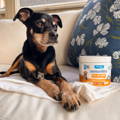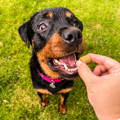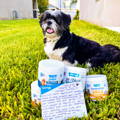Brushing Your Dog’s Teeth? Try These Vet-Approved Tips for Dog Teeth Cleaning
Jump to Section

Do you get spooked thinking about the vet bill after a dog teeth cleaning? Getting an anesthetic dental cleaning at the vet can be stressful for your pet and expensive for you. So what can you do at home to improve your dog’s dental health? Developing a healthy dental routine and brushing your dog's teeth on a routine basis can make a huge difference for your dog’s long-term dental health. If you’re wondering how to brush a dog’s teeth at home, follow along for some simple vet-approved tips!
How to brush your dog’s teeth
Step 1 – Set up a time for dog teeth cleaning
Cleaning dogs’ teeth can be easy to forget, so that’s why we recommend keeping a consistent schedule for your dog’s dental routine! It also makes it more predictable for your dog, so that they’ll come to expect it and (hopefully) be more cooperative when it’s time to brush.
Having trouble remembering to brush your dog’s teeth? Keeping your dog’s dental wipes or toothbrush near your own toothbrush might help remind you.
Step 2 – Read your dog’s mood
Dog not playing by your rules? If your dog isn’t sitting still for their daily dental cleaning, don’t force it. Give them a few minutes and revisit the task when they’re feeling more calm. Using a calming chew or two can also help!
Step 3 – Prepare your dog toothbrush & toothpaste
With clean or gloved hands, prep your dog toothbrush (or dog teeth cleaning tool of choice) and add any desired tooth gel or toothpaste. Keep it at the ready while moving on to step 4. Note: If your dog tends to be skittish or impatient during teeth cleanings, opt for a convenient alternative to a dog toothbrush like a pre-moistened dental wipe for dogs.
Step 4 – Rub your pet’s head and chin
Warm up your pup by getting them used to the touch of your hands near their mouth. This could mean petting the head, scratching behind the ears, or rubbing their chin. You can also let them sniff or lick the toothbrush to get them comfortable with the teeth-cleaning tool you choose.
Step 5 – Begin cleaning your dog’s teeth
Once your dog is primed and relaxed for their dental cleaning, gently lift the lips to reveal the teeth. You’ll be starting with the 4 canine teeth, which are the longer, fang-like teeth on the top and bottom rows of teeth and closer to the front teeth.
Start by gently brushing the canine teeth for about 3-5 seconds per tooth. Continue to pet and verbally reassure your pet as you go! You only need to spend about 3-5 seconds on each tooth.
Next, brush the premolars on the sides of the mouth and the molars near the back of the mouth. Finally, clean the incisors, which are the teeth at the front (between the canines). If you’re using a dental gel, toothpaste, or pre-moistened wipe, spread the excess solution along the rest of the teeth.
Step 6 – Reward your dog with affection
As a reward for their cooperation, give your dog some praise! Positive words and gentle pets can go a long way in letting your dog know that teeth cleaning time is nothing to be feared.
PET FACT
While cavities in dogs are somewhat rare, 80-90% of dogs over the age of 3 will have acquired some form of periodontal disease.
Should I use a toothbrush for dog teeth cleaning?
The ultimate goal of dog teeth cleaning is to remove the buildup of food debris and bacteria that causes plaque. The hardening of plaque becomes tartar, which can lead to more severe dental problems.
A variety of tools can help with this, but we recommend finding the tool that a) your pet doesn’t mind and b) makes teeth cleaning easy for you. The easier the tool is to use, the higher the likelihood of successful teeth cleaning for your dog.
1. Dog toothbrush
Some pet parents prefer to use a traditional toothbrush for dogs. If you do, remember a few important details! First, only use soft bristles that won’t irritate your pup’s gums. Second, avoid toothbrushes with rubber bumps, bristles, or tongue-scraping pads that could break off and be swallowed by your dog.
Third, choose a size of toothbrush that suits your dog's needs. Smaller dogs have little teeth and generally do better with smaller brushes, while larger dogs have bigger teeth and usually do better with larger brushes.
You can boost the cleansing power of your toothbrush for dogs with more than just water. Try loading up the bristles with a dental gel or dog toothpaste to make the experience tastier (and more effective).
2. Dog dental wipe
Dental wipes usually come pre-moistened with teeth-cleaning ingredients. Some dental wipes come with textured surfaces to polish or remove buildup from the surface of the teeth. They slip directly over the finger and glide easily over the teeth, making them a great option for dogs with little patience for teeth cleaning!
If your dog is more cooperative, you can try getting your nail behind the dental wipe to gently scrape away from the gumline for an enhanced cleaning effect.
3. Rubber dog toothbrush
Also called finger toothbrushes, this variation of a dog toothbrush is made from rubber or silicone. They work by slipping over the finger and scrubbing the teeth with rubber or silicone bristles. As with a regular toothbrush, you can add a dental gel or toothpaste for dogs for a more active clean.

How often should I brush my dog’s teeth?
When should I brush my dog's teeth?
Other home remedies for cleaning your dog’s teeth
In addition to daily brushing, there are several other effective home remedies to help keep your dog's teeth clean and healthy. One convenient option is using dental wipes designed specifically for dogs. These wipes are easy to use and can effectively remove plaque and bacteria from your dog’s teeth and gums. Simply wrap the wipe around your finger and gently rub it over your dog’s teeth, paying special attention to the gum line. Dental wipes are a great alternative for dogs who might be resistant to brushing, offering a quick and effective way to maintain oral hygiene.
Incorporating certain foods into your dog's diet can also contribute to cleaner teeth. Dry dog food, or kibble, is generally better for dental health compared to wet food because its crunchy texture helps scrape away plaque. Additionally, offering your dog safe, crunchy vegetables like carrots can provide a natural way to clean their teeth. The act of chewing on these vegetables can help remove food particles and reduce plaque buildup, while also providing a healthy snack that dogs love. Always ensure that the foods you give are safe for dogs and do not pose a choking hazard.
Teeth-cleaning toys and treats are another excellent addition to your dog’s dental care routine. Many toys are designed with ridges and textures that help clean your dog’s teeth as they chew, promoting healthier gums and reducing plaque. Dental treats, formulated to support oral health, often contain ingredients that help break down plaque and freshen breath. Combining these tools with regular brushing and dental wipes creates a comprehensive approach to maintaining your dog’s oral hygiene. By utilizing a variety of home remedies, you can effectively support your dog's dental health and keep their smile bright and healthy.
Benefits of daily dog teeth cleaning
Dog teeth cleanings don’t have to take a long time––especially if they’re done every day. To avoid potentially serious health issues–some that go beyond your dog’s teeth and gums–60 seconds or less per day is worth it.
Practicing good dental hygiene with your dog can help prevent:
- Bad dog breath
- Gum tenderness
- Gum inflammation
- Tooth pain
- Pain when eating
- Excessive drooling
- Cavities
- Gingivitis
- Dental abscesses
- Periodontal disease
- Some forms of oral cancer
- Dental-related heart disease
- Organ infection, like liver or kidney disease
- Eye inflammation (potentially leading to blindness)
- Bone deformities or fractures in the jaw and surrounding structures
- Oronasal fistula (an abnormal opening between the oral and nasal cavities)
- Potential for tooth loss or extraction under anesthesia
The less you do dog teeth cleanings at home, the more often your dog will require dental cleanings from the vet! But even with regular brushing, most dogs should get a thorough tooth and gum cleaning and dental evaluation from the vet once a year. This helps you maintain your dog’s optimal oral health and allows your vet to stay ahead of potential issues.
Most dog dental cleanings require general anesthesia to keep them comfortable and pain-free during the procedure. Don’t worry––a good veterinarian will explain the process in detail, answer any questions you might have, and ensure your pet is well taken care of during their visit!
Dogs needing complicated dental care like root canals, teeth rebuilds, or removal of certain benign and malignant cancers, should have dental procedures performed by board-certified veterinary dentists. They’re the most experienced veterinarians in the realm of pet dentistry! Your veterinarian can refer you to a veterinary dentist if your pet needs one.
How do I brush my dog’s teeth? Our answer is a) safely and b) in a way that makes it easiest on you and your pet! Don’t underestimate the importance of bonding, trust, and positive reinforcement during the process. You’ll have an easy teeth-cleaning routine down in no time!
Join the Pack!

Sign up for exclusive deals, curated pet tips from veterinarians, and product launches!
Pet Parents are Also Reading...
April, 2023
Related Articles























